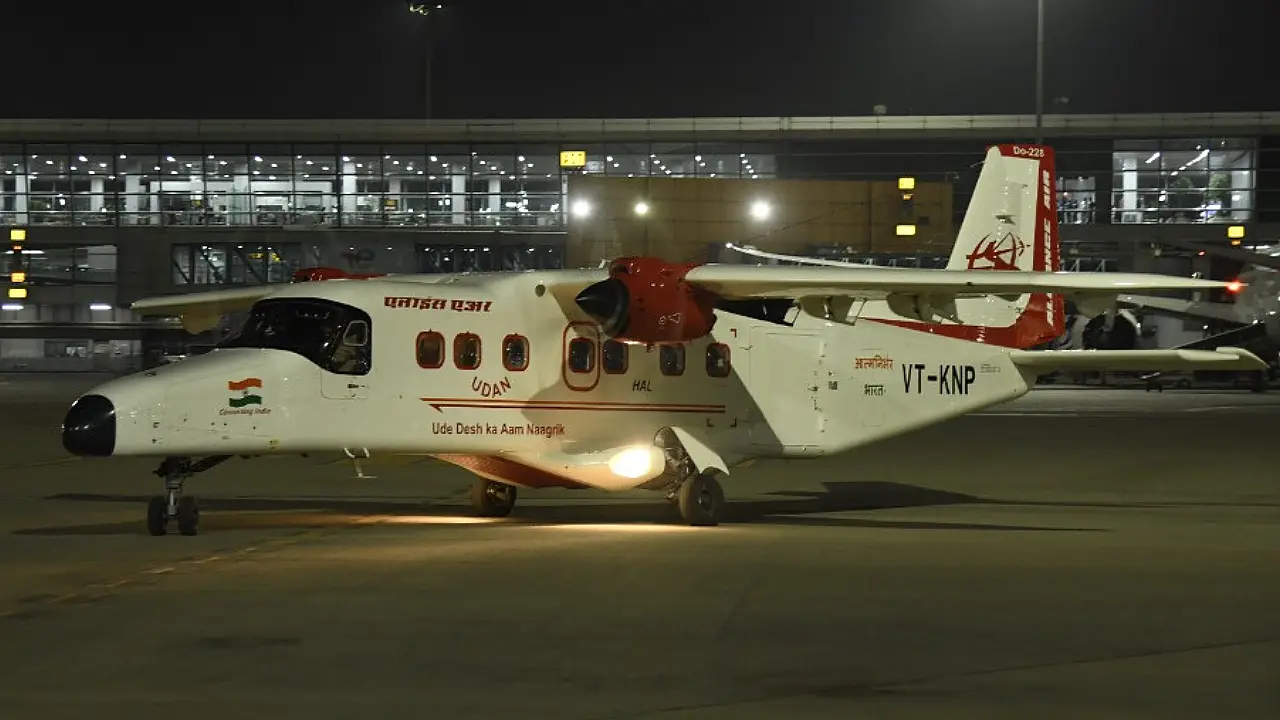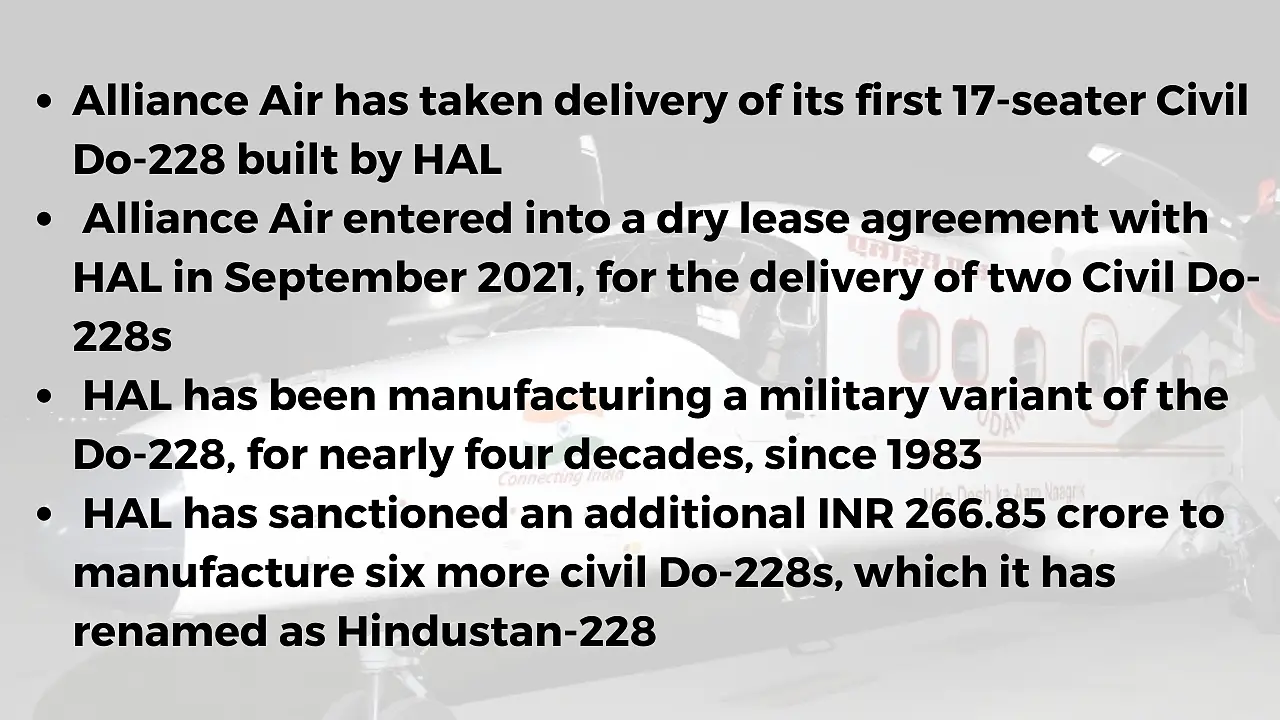
Alliance Air, a subsidiary of Air India Assets Holding, has taken delivery of its first Civil Do-228 built by state-owned airframer Hindustan Aeronautics Limited (HAL). The aircraft was delivered on April 7th, marking the first of two Civil Do-228s, taken on dry lease from HAL. Alliance Air entered into a lease agreement with HAL last September to deliver two aircraft for regional operations in Arunachal Pradesh under the Regional Connectivity Scheme (RCS).
Under the RCS, the Government underwrites a proportion of the costs incurred by airlines operating in smaller regional sectors to promote air-connectivity in these areas. Alliance Air operates flights mostly to Tier-2/3 cities or those linking these cities to the metro hubs. The new aircraft joins Alliance Air’s fleet of 18 ATR 72-600 (70/72 seater) aircraft, which it operates on a daily schedule of 64 flights and a weekly schedule of 450 flights.
New Addition
Alliance Air has acquired the Civil Do-228 in the role of a light transport aircraft to facilitate regional connectivity in northeastern states and afford better connectivity. The airline has opted for the commuter version of the aircraft with 17 seats and a toilet. HAL’s other variant can seat 19 passengers but does not have a toilet. Both aircraft variants have a galley, enabling hot drinks to be served onboard. However, a key drawback of the aircraft remains the fact that passengers cannot stand up straight in the cabin. Passenger space and comfort for short flights, however, are acceptable.

Flying at its optimum speed for maximum range, the Civil Do-228 has a fuel consumption of 245-271 kg/hr. According to HAL figures, a typical flight profile will involve a flight time of just under one hour, in which the aircraft will travel a distance of 280 km and use 229 kg of fuel. The aircraft has a Max Take-Off Weight (MTOW) of 6,200 kg, including two pilots (170 kg), passengers with baggage (1620 kg) and 610 kg of fuel.
The 17-seater Do-228’s rectangular non-pressurised fuselage allows for economical and trouble-free structural maintenance with minimum downtime compared to an aircraft with a pressurised fuselage. The light aircraft’s large cargo door also affords easy baggage access, reducing aircraft turn-around times. This can be further hastened by carrying steps in the cargo bay so that passengers can be quickly disembarked at smaller airfields without the need to wait for steps for passengers to deplane. The front and rear baggage compartments can accommodate 120 kg and 210 kg of luggage, respectively.
New Civilian Commuter
HAL has renamed the Do-228 civil variant as the ‘Hindustan-228’ and is promoting the light transport aircraft as being well suited for operations in the hilly North-East. The aircraft has excellent Short Take-Off and Landing (STOL) capability, which allows it to operate from semi-prepared runways. HAL decided to proceed with developing a civil-variant of the aircraft in February 2016 after committing in-house funding to the tune of INR 100 crore. The metal cut for the first aircraft took place in March 2016.
According to the Ministry of Defence (MoD) figures released in February, HAL allocated INR 94.41 crore from internal resources to develop the Hindustan-228 prototype aircraft and indigenisation of various systems. As of December 2021, the total funds sanctioned and released by HAL to manufacture the prototype and Type Certification tasks from the Directorate General of Civil Aviation (DGCA) was INR 72.33 crore. It sanctioned an additional INR 266.85 crore to make six more civil Do-228s.
HAL has fitted a full glass cockpit and digital autopilot on the Hindustan-228’, powered by Garret TPE-331-10 turboprop engines integrated with five-bladed composite propellers, generating 776 shaft horsepower (SHP) each.
Military variants of the Do-228 delivered by HAL are powered by two older Garrett TPE-331-5-252D engines, driving four-bladed Hartzell propellers and putting out 715 SHP. Both engines are manufactured under licence from Honeywell at HAL’s Engine Division in Bengaluru, and the former has an exclusive manufacturing relationship with HAL to source TPE 331 -10/-12 engines for its global customer base.

HAL’s Transport Aircraft Division (TAD) at Kanpur successfully carried out the Hindustan-228’s first engine ground run last May, following which ‘Ground Run’ and ‘Low-Speed Taxi Trials’ took place in August. HAL has also inked two MoUs with foreign firms to explore the possible development of an amphibian variant of the Hindustan-228 aircraft, though it has made no financial commitment. The Hindustan-228 is also available as an air ambulance with two stretchers, portable oxygen and additional seats for paramedical staff.
HAL has manufactured 19-seater Do-228s at TAD Kanpur, which was identified as the production agency for the Do-228 in 1983. The aircraft was built under a Transfer of Technology (ToT) agreement from the erstwhile Dornier company in Germany. In 2002, the Swiss firm RUAG International took over all rights for the production of the Do228 from the then German aircraft manufacturer Fairchild Dornier.
In the nearly four decades since 1983, HAL has produced 150 Do-228s for its customers in the Indian armed forces, Coast Guard and paramilitary forces as also for exports. The erstwhile Government also operated the Do-228 owned airline Vayudoot, which was shut down in the mid-nineties. Unlike the ill-fated Vayudoot, Alliance Air will be hoping that the Dornier 228’s traditional characteristics
of longer range, high utilisation rates and payloads with comparatively low operating costs, and its robustness, will allow it to operate the type profitably.